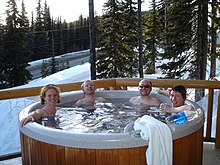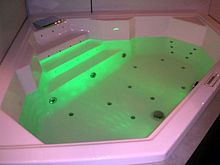Whirlpool (pool)
A whirlpool , also jacuzzi [ dʒəˈkuːzɪ ] or hottub (German spelling of English "hot tub"), is a pool of water into which air is blown through nozzles and / or powerful water jets are generated. Air bubbles cause a rather gentle and flat massage, water jets a more powerful and selective massage.
Whirlpools can be found in wellness centers , spa areas, hotels and increasingly also in private homes inside and outside closed rooms. Whirlpools usually offer space for three to eight people (massage seats), whirlpools for one or two people.
How the whirl system works
A whirlpool is a tub (round, square, elliptical, rectangular, triangular, oval, circular, etc.) with one or more nozzles (jets) with one or more outlets (ports) for water to which additional air can be added. In addition to the "water bubble bath", which is usually perceived as pleasantly relaxing, the water jets provide a massage for various body regions (back, feet, thighs, etc.).
application
Whirlpools are used for recreation or medical therapy . You will e.g. B. in hospitals, health clinics , wellness hotels or swinger clubs , but also in the private sector for recreation or therapeutic purposes.
Some manufacturers offer options for color light therapy , sound therapy and aromatherapy for their whirlpools . Whirlpools are said to provide relief from cardiovascular diseases, rheumatism, back pain, osteoporosis, sleep disorders, diabetes or asthma. The underwater massage stimulates the metabolism and promotes blood circulation. If you already have a disease, especially cardiovascular problems and rheumatism, you should consult a doctor, because some of these diseases require strict attention to the time and temperature during treatment with whirlpools. Long warm baths are also not recommended for those with varicose veins.
There are also hot tubs with individually adjustable massage jets.
The use of whirlpools for health care and promotion is recommended , for example, by the German Society for Health Care (DGGV).
hygiene
The warm water is a good nutrient medium for all kinds of germs, such as bacteria and fungi . The contamination can be harmless or, in the worst case, pathogenic (disease-causing). Thanks to the bubbling effect, even the smallest respirable (possibly germ-contaminated) water droplets ( aerosols ) can be inhaled. Bad or wrong cleaned whirlpools are therefore occasionally with Legionnaires' disease associated (1999 Bovenkarspel / Netherlands, 28 deaths) . If contaminated water is already smelled, the contamination is so advanced that serious illnesses must be expected. After a germ contamination, the whirlpool may only be put back into operation once the contaminated water has been drained and a complete disinfection has been carried out. The whirlpool lines then have to be cleaned with a special cleaner, otherwise a sewage membrane (biofilm in the wastewater) can form, which is flushed into the tub as black spheres the next time it is used. In order to prevent contamination, fresh water is used after every use - as with the bathtub. The water in whirlpools is changed every 3–4 months with proper care. The maintenance effort for whirlpools is low thanks to the ozone system. The basic requirement for perfect water is the correct pH value of 7.2 to 7.6.
History and etymology
In English, the term whirlpool means something else (namely a water vortex / whirlpool ); what we call a whirlpool is called a hot tub, jacuzzi or spa in English. These names have developed historically and differ in nuances.
Natural hot water sources were already used in ancient times, e.g. B. from the Greeks. It is known from the Romans that in their hot baths they worked the body with metal "currycums" to promote blood circulation.
At the beginning of the 20th century, public interest in water applications reawakened. In Hollywood, the first swimming pools were built for the garden. Pascal Paddock started the industrial construction of such pools in 1925 and is considered the father of swimming pools.
For the first hot tubs (in German: hot tubs') were large wine barrels sawed in half. These constructions were later built, but they often leaked. Even today, such (reliably sealed) hot tubs (made of wooden slats, held together by clamping irons) are available.
In 1956 in the USA the Jacuzzi brothers , Italian immigrants, developed a portable hydrotherapy pump for medical purposes. In 1968 Roy Jacuzzi designed the whirlpool with jets and a pump fully integrated into the system. Today whirlpools - regardless of the manufacturer - are very often referred to as jacuzzi.
Today there are many whirlpool manufacturers who have contributed their own ideas and patents. Electronic controls and other innovations (such as wireless waterproof remote controls) have made hot tubs from various manufacturers comprehensive hydrotherapy devices.
The name Spa, which is particularly common in the USA, is derived from the name of the Belgian seaside resort Spa . Today, the word spa encompasses the most varied types of hydrotherapy .
Designs
There are now different types and different manufacturers of hot tubs. Some species are equipped with strong thermal insulation and are therefore also very suitable for outdoor use. The warm water makes bathing in the great outdoors particularly pleasant. Many models keep the water at a constant temperature by means of a temperature regulator - this means that outdoor bathing is also possible in winter.
A distinction is made between the following subgroups:
- Fixed whirlpools
- Portable spas
- Whirlpools
Fixed whirlpool
The permanently installed whirlpools can mostly be found on the verandas of private houses, in luxury hotels, swimming pools or on cruise ships .
A sub-category here is the American whirlpool , which, in contrast to the European models, offers more water volume and therefore uses more powerful pumps than the European models. These hot tubs are also frost-proof.
Portable spa
Portable spas are compact and portable. They can be set up indoors and outdoors.
The tub of a portable spa is often made from sturdy acrylic molds. Depending on the manufacturer, these are further refined with various surface treatments and coatings. Wooden or metal frames support the tubs. Manufacturers handle the side outer cladding of a mobile whirlpool (wood, plastic, through to artificial leather) just as individually as the pool shape or color. There are models that are made of highly insulating foam, in which the insulation also serves as a seat, which saves weight.
A portable spa usually contains heating elements, pump systems and filter systems and is operated on normal mains electricity. Models in which the nozzle and heating system are constantly in operation offer the advantage of high energy efficiency with good thermal insulation. Some manufacturers state that energy costs are less than two euros per day in operation. Most pools also have insulating lids so that the hot tub can be closed when not in use.
Whirlpool
A whirlpool is a bathtub that is equipped with a whirl system.
The water is usually after each swim gear, like a bathtub without whirl system , drained. This eliminates the need for water treatment.
However, good hygiene is essential here as well; it is often provided by draining residual water, optimally designed hoses and self-draining nozzles in combination with ozone disinfection and liquid disinfection systems. When using bath additives in whirlpool tubs, it should be noted that foaming or highly oily products as well as additives that contain solid particles (e.g. peelings) are often deposited in the hose system and can thus impair the hygiene and function of the whirlpool bathtub.
The bathtub can be made of acrylic or sheet steel . The shape of the tub is independent of the whirlpool system. What is particularly practical about whirlpools is that usually no more space is required than for a normal bathtub without a whirlpool system. Only an additional power connection has to be provided in the area of the tub. This makes it possible to use the water massage in your own bathroom. It is easy to use at any time and can therefore be easily integrated into everyday life.
The whirl system consists of a pump that sucks water out of the bathtub and pumps it back into the bathtub with pressure. This is done using water nozzles that are located below the water level on the side of the tub, in the back or foot area. The arrangement of the nozzles towards the body creates a massage effect. The better the arrangement is tailored to the bather and the better the water pressure can be adjusted, the greater the achievable effect in terms of health promotion and health care. Back pain or tension, such as B. are often caused by sedentary activities, can sometimes be alleviated quite easily, or this can be prevented. It is advisable to consult the attending physician beforehand, especially in the case of known previous illnesses and severe complaints.
Furthermore, the whirl system can be equipped with a blower with which ambient air is blown into the tub via air nozzles. The air nozzles are mainly located on the bottom of the tub and connected to the fan via air lines. The water is set in motion by the air bubbles; this has a loosening and relaxing effect on the muscles . Enriching the water with oxygen can also have beneficial effects. a. for the skin. Different effects can be achieved and the resulting noise level can be decisively influenced by different variants with regard to the nozzles used and the performance and controllability of the blower. Last but not least, the air bubbles have a calming effect and can be used, for. B. make it easier to fall asleep.
Whirl systems are available as a water system, an air system or a combination of both. A special variant are so-called champagne systems, in which air and water can be mixed in the nozzle. This creates a particularly fine-pearled massage jet.
See also
- Hydrotherapy = the methodical use of water for the treatment of acute or chronic complaints, for the stabilization of body functions ( hardening ), for prevention, rehabilitation and / or regeneration .
- Balneology = the teaching of the therapeutic use of natural healing springs , healing gases and peloids, etc. a. in the form of baths.
- Hot Pot - hot water basins in Iceland
literature
- Axel Gehrke: Sauna, steam bath, whirlpool: comparative experimental studies of the effects on cardiovascular and endocrine parameters . Hippokrates-Verlag, Stuttgart 1989, ISBN 3-7773-0954-0 .
- V. Ulbert, FX Eich, A. Gehrke: The effect of the hot water bubble bath (hot whirlpool) on the state of mind. A psychological test examination . 1982 (cited: Phys Med Baln Med).
- K. Ammera, P. Melnizkyb: Medicinal baths for the therapy of generalized fibromyalgia . doi : 10.1159 / 000021214 (Researcher Complementary Medicine 6 (1999), pp. 80–85, K. Ammera: Ludwig Boltzmann Research Center for Physical Diagnostics and P. Melnizkyb: Institute for Physical Medicine, Hanuschkrankenhaus, Vienna; also: abstract , link to pdf ).


